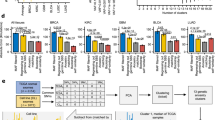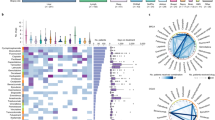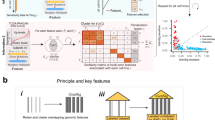Abstract
Identifying genetic variants associated with chemotherapeutic induced toxicity is an important step towards personalized treatment of cancer patients. However, annotating and interpreting the associated genetic variants remains challenging because each associated variant is a surrogate for many other variants in the same region. The issue is further complicated when investigating patterns of associated variants with multiple drugs. In this study, we used biological knowledge to annotate and compare genetic variants associated with cellular sensitivity to mechanistically distinct chemotherapeutic drugs, including platinating agents (cisplatin, carboplatin), capecitabine, cytarabine, and paclitaxel. The most significantly associated SNPs from genome wide association studies of cellular sensitivity to each drug in lymphoblastoid cell lines derived from populations of European (CEU) and African (YRI) descent were analyzed for their enrichment in biological pathways and processes. We annotated genetic variants using higher-level biological annotations in efforts to group variants into more interpretable biological modules. Using the higher-level annotations, we observed distinct biological modules associated with cell line populations as well as classes of chemotherapeutic drugs. We also integrated genetic variants and gene expression variables to build predictive models for chemotherapeutic drug cytotoxicity and prioritized the network models based on the enrichment of DNA regulatory data. Several biological annotations, often encompassing different SNPs, were replicated in independent datasets. By using biological knowledge and DNA regulatory information, we propose a novel approach for jointly analyzing genetic variants associated with multiple chemotherapeutic drugs.
This is a preview of subscription content, access via your institution
Access options
Subscribe to this journal
Receive 6 print issues and online access
$259.00 per year
only $43.17 per issue
Buy this article
- Purchase on Springer Link
- Instant access to full article PDF
Prices may be subject to local taxes which are calculated during checkout




Similar content being viewed by others
References
FACT SHEET: investing in the National Cancer Moonshot | whitehouse.gov. 2016. https://www.whitehouse.gov/the-press-office/2016/02/01/fact-sheet-investing-national-cancer-moonshot.
Wheeler HE, Dolan ME. Lymphoblastoid cell lines in pharmacogenomic discovery and clinical translation. Pharmacogenomics. 2012;13:55–70.
Huang RS, Duan S, Kistner EO, Hartford CM, Dolan ME. Genetic variants associated with carboplatin-induced cytotoxicity in cell lines derived from Africans. Mol Cancer Ther. 2008;7:3038–46. http://www.pubmedcentral.nih.gov/articlerender.fcgi?artid=2743011&tool=pmcentrez&rendertype=abstract.
Wheeler HE, Gamazon ER, Stark aL, O’Donnell PH, Gorsic LK, Huang RS, et al. Genome-wide meta-analysis identifies variants associated with platinating agent susceptibility across populations. Pharm J. 2011;13:35–43. http://www.nature.com/doifinder/10.1038/tpj.2011.38.
Huang RS, Duan S, Bleibel WK, Kistner EO, Zhang W, Clark Ta, et al. A genome-wide approach to identify genetic variants that contribute to etoposide-induced cytotoxicity. Proc Natl Acad Sci USA. 2007;104:9758–63. http://www.pubmedcentral.nih.gov/articlerender.fcgi?artid=1887589&tool=pmcentrez&rendertype=abstract.
Huang RS, Duan S, Shukla SJ, Kistner EO, Clark Ta, Chen TX, et al. Identification of genetic variants contributing to cisplatin-induced cytotoxicity by use of a genomewide approach. Am J Hum Genet. 2007;81:427–37. http://www.pubmedcentral.nih.gov/articlerender.fcgi?artid=1950832&tool=pmcentrez&rendertype=abstract.
Borghaei H, Langer CJ, Millenson M, Ruth KJ, Litwin S, Tuttle H, et al. Phase II study of paclitaxel, carboplatin, and cetuximab as first line treatment, for patients with advanced non-small cell lung cancer (NSCLC). J Thorac Oncol. 2008;3:1286–92. http://www.ncbi.nlm.nih.gov/pubmed/18978564.
McWhinney SR, Goldberg RM, McLeod HL. Platinum neurotoxicity pharmacogenetics. Mol Cancer Ther. 2009;8:10–6. http://www.pubmedcentral.nih.gov/articlerender.fcgi?artid=2651829&tool=pmcentrez&rendertype=abstract.
Rabik CA, Dolan ME. Molecular mechanisms of resistance and toxicity associated with platinating agents. Cancer Treat Rev. 2007;33:9–23. http://www.pubmedcentral.nih.gov/articlerender.fcgi?artid=1855222&tool=pmcentrez&rendertype=abstract.
Cassidy J, Saltz L, Twelves C, Van Cutsem E, Hoff P, Kang Y, et al. Efficacy of capecitabine versus 5-fluorouracil in colorectal and gastric cancers: a meta-analysis of individual data from 6171 patients. Ann Oncol. 2011;22:2604–9. http://www.ncbi.nlm.nih.gov/pubmed/21415237.
Kumar CC. Genetic abnormalities and challenges in the treatment of acute myeloid leukemia. Genes Cancer. 2011;2:95–107. http://www.pubmedcentral.nih.gov/articlerender.fcgi?artid=3111245&tool=pmcentrez&rendertype=abstract.
Rowinsky EK, Wright M, Monsarrat B, Donehower RC. Clinical pharmacology and metabolism of taxol (paclitaxel): update 1993. Ann Oncol. 1994;5:S7–16. http://www.ncbi.nlm.nih.gov/pubmed/7865438.
Huang RS, Kistner EO, Bleibel WK, Shukla SJ, Dolan ME. Effect of population and gender on chemotherapeutic agent-induced cytotoxicity. Mol Cancer Ther. 2007;6:31–6. http://www.pubmedcentral.nih.gov/articlerender.fcgi?artid=2669540&tool=pmcentrez&rendertype=abstract.
Zhang W, Duan S, Kistner EO, Bleibel WK, Huang RS, Clark TA, et al. Evaluation of genetic variation contributing to differences in gene expression between populations. Am J Hum Genet. 2008;82:631–40. http://www.sciencedirect.com/science/article/pii/S0002929708001365.
Gamazon ER, Huang RS, Cox NJ, Dolan ME. Chemotherapeutic drug susceptibility associated SNPs are enriched in expression quantitative trait loci. Proc Natl Acad Sci USA. 2010;107:9287–92. http://www.pubmedcentral.nih.gov/articlerender.fcgi?artid=2889115&tool=pmcentrez&rendertype=abstract.
Schork AJ, Thompson WK, Pham P, Torkamani A, Roddey JC, Sullivan PF, et al. All SNPs are not created equal: genome-wide association studies reveal a consistent pattern of enrichment among functionally annotated SNPs. PLoS Genet. 2013;9:e1003449. http://journals.plos.org/plosgenetics/article?id=10.1371/journal.pgen.1003449.
Hindorff LA, Sethupathy P, Junkins HA, Ramos EM, Mehta JP, Collins FS, et al. Potential etiologic and functional implications of genome-wide association loci for human diseases and traits. Proc Natl Acad Sci USA. 2009;106:9362–7. http://www.pubmedcentral.nih.gov/articlerender.fcgi?artid=2687147&tool=pmcentrez&rendertype=abstract.
O’Donnell PH, Stark AL, Gamazon ER, Wheeler HE, McIlwee BE, Gorsic L, et al. Identification of novel germline polymorphisms governing capecitabine sensitivity. Cancer. 2012;118:4063–73. http://www.pubmedcentral.nih.gov/articlerender.fcgi?artid=3413892&tool=pmcentrez&rendertype=abstract.
Abecasis GR, Auton A, Brooks LD, DePristo Ma, Durbin RM, Handsaker RE, et al. An integrated map of genetic variation from 1,092 human genomes. Nature. 2012;491:56–65. http://www.pubmedcentral.nih.gov/articlerender.fcgi?artid=3498066&tool=pmcentrez&rendertype=abstract.
Lappalainen T, Sammeth M, Friedländer MR, ’t Hoen PaC, Monlong J, Rivas Ma, et al. Transcriptome and genome sequencing uncovers functional variation in humans. Nature. 2013;501:506–11. http://www.ncbi.nlm.nih.gov/pubmed/24037378.
Hartford CM, Duan S, Delaney SM, Mi S, Kistner EO, Lamba JK, et al. Population-specific genetic variants important in susceptibility to cytarabine arabinoside cytotoxicity. Blood. 2009;113:2145–53. http://www.pubmedcentral.nih.gov/articlerender.fcgi?artid=2652364&tool=pmcentrez&rendertype=abstract.
Wen Y, Gorsic LK, Wheeler HE, Ziliak DM, Huang RS, Dolan ME. Chemotherapeutic-induced apoptosis: a phenotype for pharmacogenomics studies. Pharm Genom. 2011;21:476–88. http://www.pubmedcentral.nih.gov/articlerender.fcgi?artid=3134538&tool=pmcentrez&rendertype=abstract.
McKenna A, Hanna M, Banks E, Sivachenko A, Cibulskis K, Kernytsky A, et al. The genome analysis Toolkit: a MapReduce framework for analyzing next-generation DNA sequencing data. Genome Res. 2010;20:1297–303. http://www.pubmedcentral.nih.gov/articlerender.fcgi?artid=2928508&tool=pmcentrez&rendertype=abstract.
Purcell S, Neale B, Todd-Brown K, Thomas L, Ferreira MAR, Bender D, et al. PLINK: a tool set for whole-genome association and population-based linkage analyses. Am J Hum Genet. 2007;81:559–75. http://www.pubmedcentral.nih.gov/articlerender.fcgi?artid=1950838&tool=pmcentrez&rendertype=abstract.
Price AL, Patterson NJ, Plenge RM, Weinblatt ME, Shadick NA, Reich D. Principal components analysis corrects for stratification in genome-wide association studies. Nat Genet. 2006;38:904–9. Epub 2006 Jul 23.
Bush WS, Dudek SM, Ritchie MD. Biofilter: a knowledge-integration system for the multi-locus analysis of genome-wide association studies. Pac Symp Biocomput. 2009. http://www.pubmedcentral.nih.gov/articlerender.fcgi?artid=2859610&tool=pmcentrez&rendertype=abstract.
Aken BL, Ayling S, Barrell D, Clarke L, Curwen V, Fairley S, et al. The Ensembl gene annotation system. Database. 2016. http://www.ncbi.nlm.nih.gov/pubmed/27337980.
Finn RD, Bateman A, Clements J, Coggill P, Eberhardt RY, Eddy SR, et al. Pfam: the protein families database. Nucleic Acids Res. 2014;42:D222–30. https://academic.oup.com/nar/article-lookup/doi.org/10.1093/nar/gkt1223.
Ashburner M, Ball CA, Blake JA, Botstein D, Butler H, Cherry JM, et al. Gene ontology: tool for the unification of biology. The gene ontology consortium. Nat Genet. 2000;25:25–9. http://www.pubmedcentral.nih.gov/articlerender.fcgi?artid=3037419&tool=pmcentrez&rendertype=abstract.
Kanehisa M, Goto S. KEGG: kyoto encyclopedia of genes and genomes. Nucleic Acids Res. 2000;28:27–30. http://www.pubmedcentral.nih.gov/articlerender.fcgi?artid=102409&tool=pmcentrez&rendertype=abstract.
Vastrik I, D’Eustachio P, Schmidt E, Joshi-Tope G, Gopinath G, Croft D, et al. Reactome: a knowledge base of biologic pathways and processes. Genome Biol. 2007;8:R39. http://www.ncbi.nlm.nih.gov/pubmed/17367534.
Kim D, Li R, Dudek SM, Frase AT, Pendergrass SA, Ritchie MD. Knowledge-driven genomic interactions: an application in ovarian cancer. BioData Min. 2014;7:20. http://www.pubmedcentral.nih.gov/articlerender.fcgi?artid=4161273&tool=pmcentrez&rendertype=abstract.
Holzinger ER, Dudek SM, Frase AT, Krauss RM, Medina MW, Ritchie MD. ATHENA: a tool for meta-dimensional analysis applied to genotypes and gene expression data to predict HDL cholesterol levels. Pac Symp Biocomput. 2013. http://www.pubmedcentral.nih.gov/articlerender.fcgi?artid=3587764&tool=pmcentrez&rendertype=abstract.
Holzinger ER, Dudek SM, Frase AT, Pendergrass Sa, Ritchie MD. ATHENA: the analysis tool for heritable and environmental network associations. Bioinformatics. 2014;30:698–705. http://www.ncbi.nlm.nih.gov/pubmed/24149050.
Dunham I, Kundaje A, Aldred SF, Collins PJ, Davis CA, Doyle F, et al. An integrated encyclopedia of DNA elements in the human genome. Nature. 2012;489:57–74. https://doi.org/10.1038/nature11247.
Wheeler HE, Gamazon ER, Wing C, Njiaju UO, Njoku C, Baldwin RM, et al. Integration of cell line and clinical trial genome-wide analyses supports a polygenic architecture of paclitaxel-induced sensory peripheral neuropathy. Clin Cancer Res. 2013;19:491–9. http://www.pubmedcentral.nih.gov/articlerender.fcgi?artid=3549006&tool=pmcentrez&rendertype=abstract.
Ricci MS. Chemotherapeutic approaches for targeting cell death pathways. Oncology. 2006;11:342–57. http://www.pubmedcentral.nih.gov/articlerender.fcgi?artid=3132471&tool=pmcentrez&rendertype=abstract.
Brown JM, Attardi LD. The role of apoptosis in cancer development and treatment response. Nat Rev Cancer. 2005;5:231–7. http://www.ncbi.nlm.nih.gov/pubmed/15738985.
Moen EL, Zhang X, Mu W, Delaney SM, Wing C, McQuade J, et al. Genome-wide variation of cytosine modifications between European and african populations and the implications for complex traits. Genetics. 2013;194:987–96. http://www.ncbi.nlm.nih.gov/pubmed/23792949.
Quintela-Fandino M, Arpaia E, Brenner D, Goh T, Yeung FA, Blaser H, et al. HUNK suppresses metastasis of basal type breast cancers by disrupting the interaction between PP2A and cofilin-1. Proc Natl Acad Sci USA. 2010. 107(6):2622–7. http://www.pubmedcentral.nih.gov/articlerender.fcgi?artid=2823890&tool=pmcentrez&rendertype=abstract.
Sinilnikova OM, McKay JD, Tavtigian SV, Canzian F, DeSilva D, Biessy C, et al. Haplotype-based analysis of common variation in the acetyl-coA carboxylase alpha gene and breast cancer risk: a case-control study nested within the European prospective investigation into cancer and nutrition. Cancer Epidemiol Biomark Prev. 2007;16:409–15. http://www.ncbi.nlm.nih.gov/pubmed/17372234.
Amend K, Hicks D, Ambrosone CB. Breast cancer in African-American women: differences in tumor biology from European-American women. Cancer Res. 2006;66:8327–30. http://www.ncbi.nlm.nih.gov/pubmed/16951137.
Liu H, Yang Y, Xiao J, Yang S, Liu Y, Kang W, et al. Semaphorin 4D expression is associated with a poor clinical outcome in cervical cancer patients. Microvasc Res. 2014;93:1–8. http://www.ncbi.nlm.nih.gov/pubmed/24603190.
Shen Y-M, He X, Deng H-X, Xie Y-P, Wang C-T, Wei Y-Q, et al. Overexpression of the hBiot2 gene is associated with development of human cervical cancer. Oncol Rep. 2011;25:75–80. http://www.ncbi.nlm.nih.gov/pubmed/21109960.
Rositch AF, Nowak RG, Gravitt PE. Increased age and race-specific incidence of cervical cancer after correction for hysterectomy prevalence in the United States from 2000 to 2009. Cancer. 2014;120:2032–8. http://www.pubmedcentral.nih.gov/articlerender.fcgi?artid=4073302&tool=pmcentrez&rendertype=abstract.
Houston KA, Henley SJ, Li J, White MC, Richards TB. Patterns in lung cancer incidence rates and trends by histologic type in the United States, 2004–2009. Lung Cancer. 2014;86:22–8. http://www.ncbi.nlm.nih.gov/pubmed/25172266.
Israël A. The IKK complex, a central regulator of NF-kappaB activation. Cold Spring Harb Perspect Biol. 2010;2:a000158. http://www.pubmedcentral.nih.gov/articlerender.fcgi?artid=2829958&tool=pmcentrez&rendertype=abstract.
Karin M. NF- B as a Critical Link Between Inflammation and Cancer. Cold Spring Harb Perspect Biol. 2009;1:a000141. http://www.pubmedcentral.nih.gov/articlerender.fcgi?artid=2773649&tool=pmcentrez&rendertype=abstract.
Oh CS, Toke DA, Mandala S, Martin CE. ELO2 and ELO3, homologues of the Saccharomyces cerevisiae ELO1 gene, function in fatty acid elongation and are required for sphingolipid formation. J Biol Chem. 1997;272:17376–84. http://www.ncbi.nlm.nih.gov/pubmed/9211877.
Pizer ES, Wood FD, Pasternack GR, Kuhajda FP. Fatty acid synthase (FAS): a target for cytotoxic antimetabolites in HL60 promyelocytic leukemia cells. Cancer Res. 1996;56:745–51. http://www.ncbi.nlm.nih.gov/pubmed/8631008.
Lupu R, Menendez JA. Pharmacological inhibitors of fatty acid synthase (FASN)—catalyzed endogenous fatty acid biogenesis: a new family of anti-cancer agents? Curr Pharm Biotechnol. 2006;7:483–93. http://www.ncbi.nlm.nih.gov/pubmed/17168665.
Kuhajda FP. Fatty-acid synthase and human cancer: new perspectives on its role in tumor biology. Nutrition. 2000;16:202–8. http://www.ncbi.nlm.nih.gov/pubmed/10705076.
Kuhajda FP, Pizer ES, Li JN, Mani NS, Frehywot GL, Townsend CA. Synthesis and antitumor activity of an inhibitor of fatty acid synthase. Proc Natl Acad Sci USA. 2000;97:3450–4. http://www.pubmedcentral.nih.gov/articlerender.fcgi?artid=16260&tool=pmcentrez&rendertype=abstract.
Angeles TS, Hudkins RL. Recent advances in targeting the fatty acid biosynthetic pathway using fatty acid synthase inhibitors. Expert Opin Drug Discov. 2016;11:1187–99. https://www.tandfonline.com/doi/full/10.1080/17460441.2016.1245286.
Zhang J-S, Lei J-P, Wei G-Q, Chen H, Ma C-Y, Jiang H-Z. Natural fatty acid synthase inhibitors as potent therapeutic agents for cancers: a review. Pharm Biol. 2016;209:1–7.
Reymond N, d’Água BB, Ridley AJ. Crossing the endothelial barrier during metastasis. Nat Rev Cancer. 2013;13:858–70. https://doi.org/10.1038/nrc3628.
Nicolae DL, Gamazon E, Zhang W, Duan S, Dolan ME, Cox NJ. Trait-associated SNPs are more likely to be eQTLs: annotation to enhance discovery from GWAS. PLoS Genet. 2010;6:e1000888. http://www.pubmedcentral.nih.gov/articlerender.fcgi?artid=2848547&tool=pmcentrez&rendertype=abstract.
Wheeler HE, Aquino-Michaels K, Gamazon ER, Trubetskoy VV, Dolan ME, Huang RS, et al. Poly-omic prediction of complex traits: OmicKriging. Genet Epidemiol. 2014;38:402–15. http://www.pubmedcentral.nih.gov/articlerender.fcgi?artid=4072756&tool=pmcentrez&rendertype=abstract.
Ritchie MD, Holzinger ER, Li R, Pendergrass SA, Kim D. Methods of integrating data to uncover genotype–phenotype interactions. Nat Rev Genet. 2015;16:85–97. https://doi.org/10.1038/nrg3868.
Stark AL, Zhang W, Zhou T, O’Donnell PH, Beiswanger CM, Huang RS, et al. Population differences in the rate of proliferation of international HapMap cell lines. Am J Hum Genet. 2010;87:829–33. http://www.pubmedcentral.nih.gov/articlerender.fcgi?artid=2997375&tool=pmcentrez&rendertype=abstract.
Acknowledgements
This work is supported, in part, by NSF graduate fellowship DGE1255832 (RL), NIH HG006389 (MDR), NIH P50GM115318 (MDR), and NIH/NIGMS Pharmacogenomics of Anticancer Agents Research Grant U01 GM61393 (MED).
Author information
Authors and Affiliations
Corresponding author
Ethics declarations
Conflict of interest
The authors declare that they have no conflict of interest.
Electronic supplementary material
Rights and permissions
About this article
Cite this article
Li, R., Kim, D., Wheeler, H.E. et al. Integration of genetic and functional genomics data to uncover chemotherapeutic induced cytotoxicity. Pharmacogenomics J 19, 178–190 (2019). https://doi.org/10.1038/s41397-018-0024-6
Received:
Revised:
Accepted:
Published:
Issue Date:
DOI: https://doi.org/10.1038/s41397-018-0024-6



